

Exhibition Period:
4 February 2020 (Tue) – 29 March 2020 (Sun)
Venue:
Special Exhibition Hall (3rd floor)
Opening Hours:
09:30–17:00 (Sundays, Tuesdays–Thursdays; last admission at 16:30)
09:30–20:00 (Fridays & Saturdays; last admission at 19:30)
Closed:
Mondays, except 24 Feb (the museum will be closed on Tuesday, 25 Feb)
Admission Fee:
Adults—1,600 yen (1,400 yen)
University and High School Students—900 yen (700 yen)
Junior High School and Elementary School Students—500 yen (300 yen)
Late Admission Tickets* (for entry after 17:00)
Adults—1,400 yen
University and High School Students—700 yen
Junior High School and Elementary School Students—300 yen
東京富士美術館とルネ・ユイグ氏
1983年に開館した東京富士美術館は、開館記念展「近世フランス絵画展」に引き続き「栄光の18世紀フランス名画展」及び「フランス革命とロマン主義展」を通して、フランス絵画の歴史を体系的に紹介しました。開館したばかりの無名の美術館が、フランスの有名な美術館からすぐれた作品を多数借用できたのは、アカデミー・フランセーズ会員のルネ・ユイグ氏からの働きかけがあってこそのことでした。
また東京富士美術館は、ユイグ氏の助言をもとに16世紀のイタリア絵画から20世紀の現代美術にいたる西洋美術史を一望できる、たぐいまれなコレクションを短期間に形成しました。なかでもフランス絵画の充実ぶりには特筆すべきものがあります。ユイグ氏へのオマージュをこめて開催される本展には、フランスとイギリスなどの有名美術館が所蔵する作品に加えて、東京富士美術館所蔵の重要作品も出品されています。なお、1988年には、「東京富士美術館所蔵永遠の日本の名宝展」が、当時ユイグ氏が館長をつとめていた、パリのジャックマール=アンドレ美術館で開催されています。
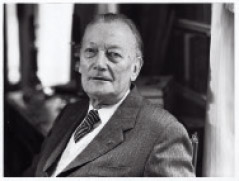
ルネ・ユイグ René Huyghe(1906−1997年)
フランスの美術史家、コレージュ・ド・フランス教授、アカデミー・フランセーズ会員。31歳の若さでルーヴル美術館絵画部長となり、展示の近代化を推進。第二次大戦中、モナリザなどルーヴル美術館所蔵絵画約4000点を疎開させ、ナチス・ドイツの略奪から守り抜いた。東京富士美術館の開館記念展や西洋美術コレクション形成にも深く関与した。晩年には、仏日文化交流の功績により勲二等旭日重光章を受章。主著にDialogue avec le visible, 1955(邦訳『見えるものとの対話』1962-1963年)、Les Puissances de l’image, 1965(邦訳『イメージの力─芸術心理学のために』1969年)のほか、ルネ・ユイグ、池田大作共著『闇は暁を求めて─美と宗教と人間の再発見』1981年などがある。
Exhibition Overview and Highlights
Part 1:
The Formation of the Grande Manière in
the Seventeenth Century
Poussin, Le Brun, and the Royal Academy of Painting
and Sculpture
The Royal Academy of Painting and Sculpture was founded in the seventeenth century, when France was under King Louis XIV’s rule. The Academy based its teachings on the paintings and theories of art put forth by painter Nicolas Poussin, who had spent most of his working life in Rome. This resulted in the birth of a distinctively French form of classicism that went on to have enduring influences on the styles of French art that followed it. This French classicism is sometimes known as the grande manière.
The Academy regarded history paintings—works which depicted scenes from classical Greek and Roman mythology and literature, as well as the Bible—as the highest genre of art. Prior to that, painters like Claude Lorrain had already developed the classical landscape, a vibrantly lyrical genre that blends elements of history painting into accurate portrayals of nature. It was upon this foundation that the painter Charles Le Brun, one of the Academy’s most influential figures, built its educational framework and established the French classical style.
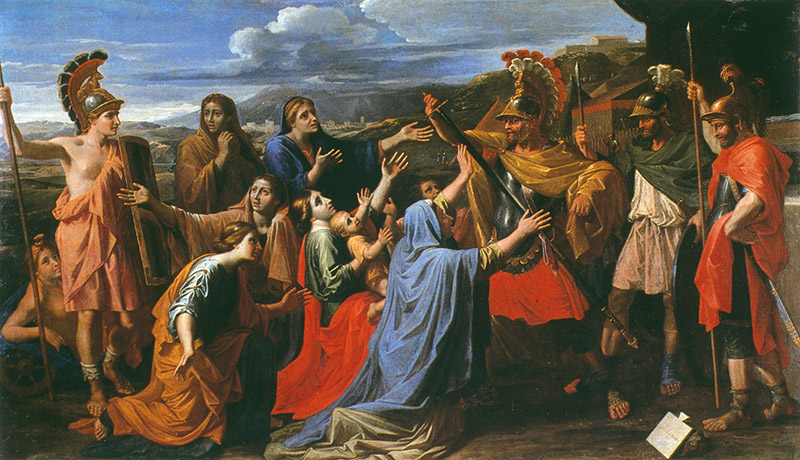
Coriolanus Entreated by His Wife and His Mother
Nicolas Poussin
ca. 1652–1653. Oil on canvas. 116×196cm. Musée Nicolas Poussin, Les Andelys
© Christophe Deronne
This exemplary history painting about the Roman general Coriolanus illustrates an ancient story about the strength of family bonds. Known as the “painter-philosopher,” Poussin believed that art should appeal not only to the eye, but also to the mind.
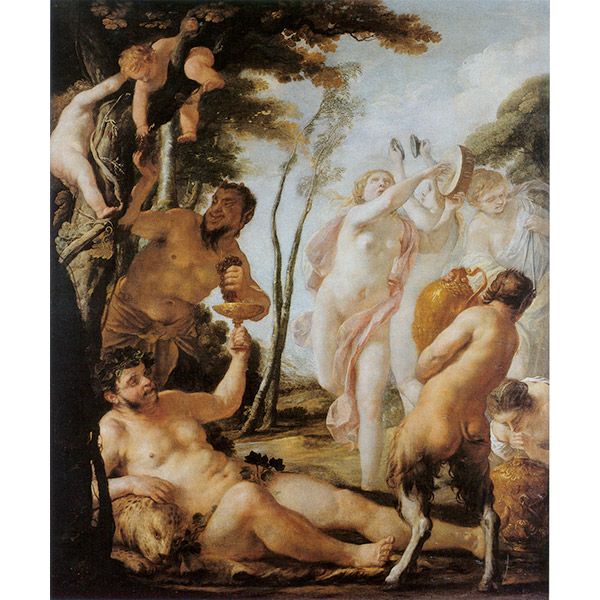
Bacchanalia
Jacques
Blanchard
1636. Oil on canvas. 138×115cm. Musée des Beaux-Arts, Nancy
© Ville de Nancy-P. Buren
This lively painting depicts a ritual held in honor of Bacchus, the Roman god of wine and agriculture. Its painter, Blanchard, brought the colorful expressiveness of Italian paintings back to his home country, earning him the nickname, “the French Titian.”
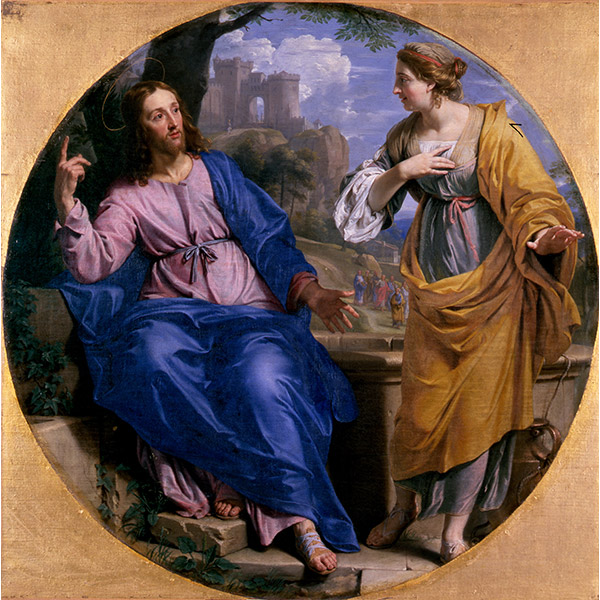
Christ and the Samaritan Woman
Philippe de Champaigne
1648. Oil on canvas. 114×113cm. Musée des Beaux-Arts, Caen
Musée des Beaux-Arts de Caen (photo: M. Seyve)
Champaigne painted this work for the Abbaye de Port-Royal des Champs, the abbey which his daughter was a nun of. It depicts Jesus asking a Samaritan woman for a drink of water. The artist was popular for his accurate portrayals of human figures, his vivid colors, and his lyrical landscapes.
Part 2:
Watteau and the Birth of Rococo
Art
New Visual Representations of Emotion
In his later years, Louis XIV grew to favor art that was more intimate and sensual. This brought about the Rococo movement. Unlike classical artists, whose works were inspired by Greek and Roman classics as well as the Bible, Rococo painters like Antoine Watteau represented the subtleties of the heart through delicate and amorous worlds filled with rich color.
Demand for more straightforward and sensually arresting works emerged against a backdrop of economic prosperity, bringing Rococo art, as exemplified by the works of François Boucher, to its peak. The wealthy began to purchase art for themselves after visiting the Salon exhibitions hosted periodically at the Louvre Palace. This led to a rise in the popularity of portraits, genre paintings, and landscapes. The latter half of the eighteenth century also saw female painters such as Élisabeth-Louise Vigée Le Brun rise to prominence.
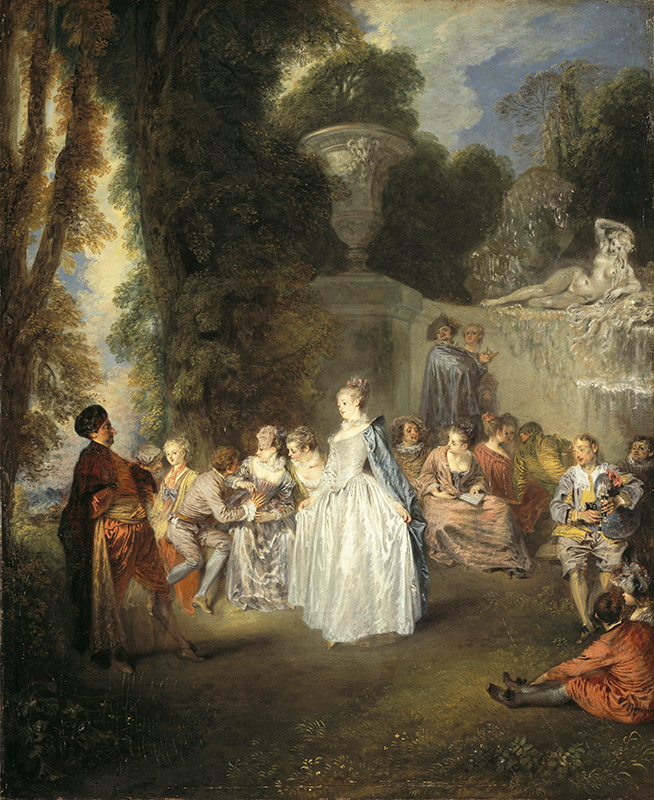
Photo Spot
Venetian Feasts
Jean-Antoine
Watteau
ca. 1718–1719. Oil on canvas. 55.9×45.7cm. National Galleries of Scotland, Edinburgh
National Galleries of Scotland; bequest of Lady Murray of Henderland, 1861
Watteau developed the fête galante, a new genre of painting depicting festive scenes with aristocrats in outdoor settings. They often feature a garden, conversation, and music, painted in rich colors. The man playing the musette in this painting is the artist himself.
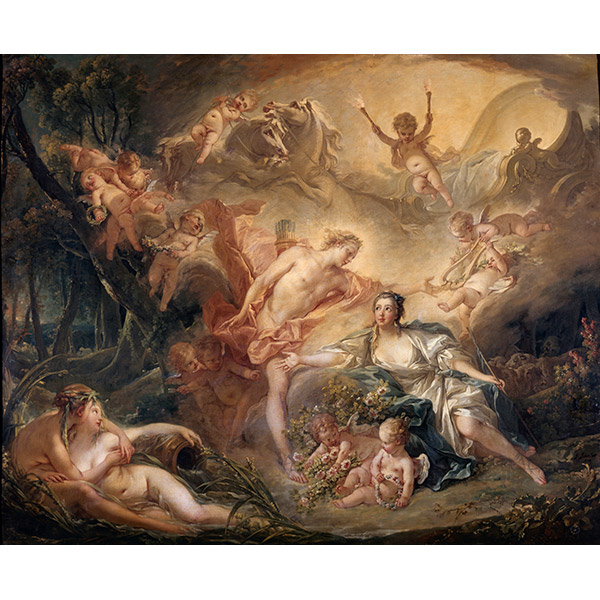
Apollo Revealing His Divinity to the Shepherdess Isse
François Boucher
1750. Oil on canvas. 129×157.5cm. Musée des Beaux-Arts, Tours
Photo © RMN-Grand Palais / Agence Bulloz / distributed by AMF
Boucher, one of the most representative of Rococo artists, conceived this painting based on Madame de Pompadour’s portrayal of Issé in the similarly titled French opéra-ballet.
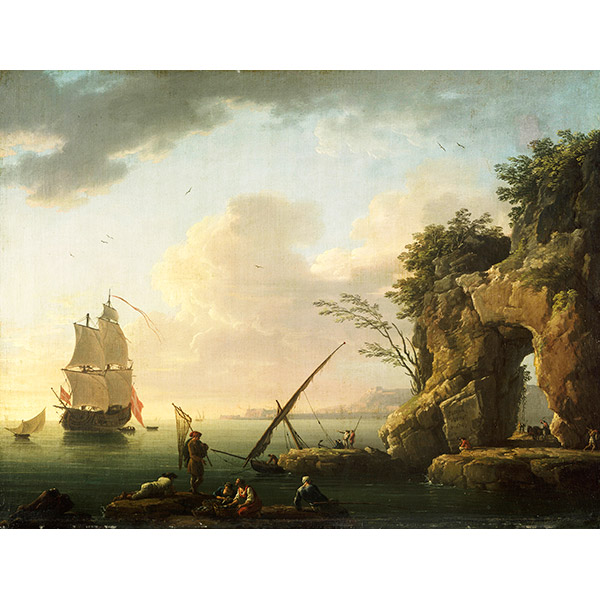
Sea, Sunset
Claude-Joseph
Vernet
1748. Oil on canvas. 48.8×64.6cm. Palais des Beaux-Arts, Lille
Photo © RMN-Grand Palais / Jacques Quecq d’Henripret / distributed by AMF
Having resided in Rome for around twenty years, Vernet brought innovation to decorative and fantastical Rococo landscape paintings by incorporating accurate portrayals of nature into them. This lyrical painting of a fisherman and his family is an example of such.
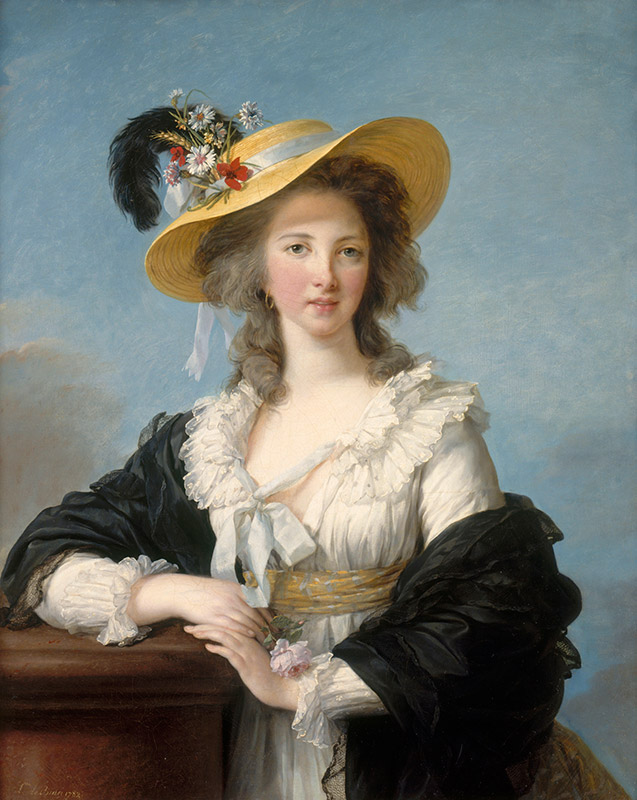
Photo Spot
Gabrielle Yolande Claude Martine de Polastron, Duchess of Polignac
Élisabeth-Louise Vigée Le Brun
1782. Oil on canvas. 92.3×73.6cm. Établissement Public du Château, du Musée et du Domaine National de Versailles
Photo © RMN-Grand Palais (Château de Versailles) / Gérard Blot / distributed by AMF
Female painter Vigée Le Brun received much favor from Queen Marie Antoinette, and painted many portraits of her and other members of the royal court. This is one of her many portraits depicting the Duchess of Polignac, who was a close friend of Marie Antoinette, and governess to the royal family.
Part 3:
Napoleon’s Legacy
Challenges to the
Artistic Tradition and the Birth of Modern Art
The numerous excavations of Pompeii and other Roman ruins around the mid-eighteenth century inspired fresh interest in classical civilizations. This coincided with increasing criticism of Rococo art for being sensuous and superficial, giving rise to the Neoclassical movement.
Napoleon’s campaigns in Egypt and Syria at that time exposed the people of France to unfamiliar cultures, advancing a contrasting yet equally influential art movement in France: Romanticism. This contact with new cultures inspired Romantic artists to begin exploring new themes in their art, such as contemporary subjects, and even the realms of insanity and unconsciousness.
After the French Revolution, art education was led by the restructured Academy of Fine Arts, which sought to train the next generation of artists to carry on the well-established French classical style. This resulted in the emergence of academic painters who highly valued drawing, and strongly advocated licked finishes—smoothed surfaces that show no obvious brushstrokes—in painting.
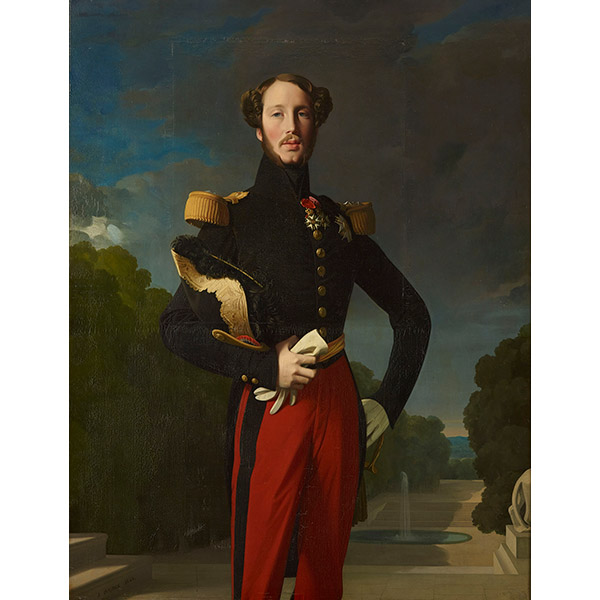
Ferdinand-Philippe, Duke of Orléans, Set against a Landscape
Jean-Auguste-Dominique Ingres
1843. Oil on canvas. 157×121.5cm. Établissement Public du Château, du Musée et du Domaine National de Versailles
Photo © Château de Versailles, Dist. RMN-Grand Palais / Christophe Fouin / distributed by AMF
Ingres’s paintings feature both accurate forms and disproportionate features that are created by curved lines. In the case of this painting, the Duke’s neck and arms are portrayed to be unusually long.
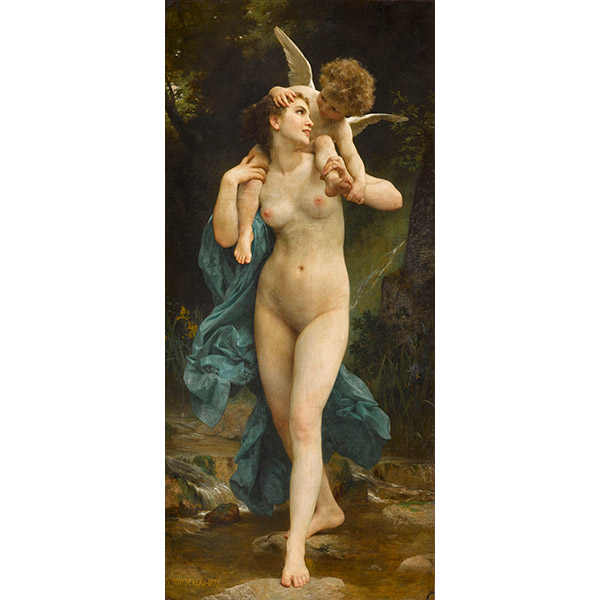
Youth and Cupid
William
Bouguereau
1877. Oil on canvas. 192.5×88cm. Musée d'Orsay, Paris
Photo © RMN-Grand Palais (musée d’Orsay) / Stéphane Maéchalle / distributed by AMF
Bouguereau created many paintings of naked women under the guise of painting figures from mythology and literature. This made him the target of much criticism, but also made his paintings popular. The young woman carrying Cupid on her shoulders represents youth. The Academy considered it an artist’s mission to create idealized depictions of beauty with a licked finish.
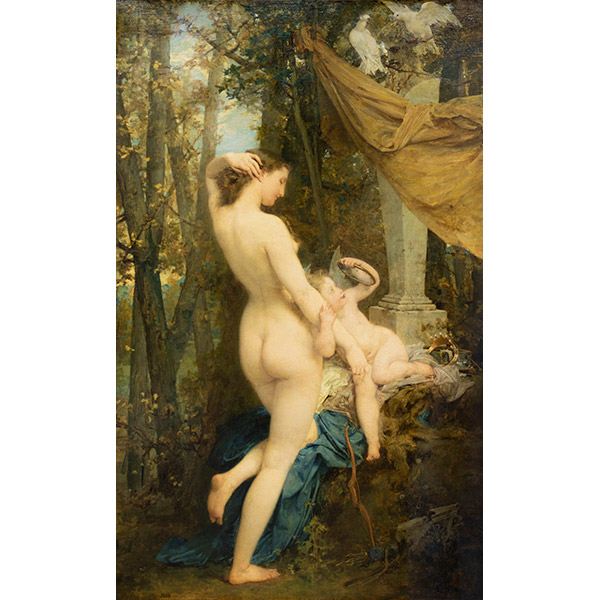
The Toilette of Venus
Paul
Baudry
1858. Oil on canvas. 136×84cm. Musée des Beaux-Arts, Bordeaux
© Musée des Beaux-Arts, Bordeaux (photo: F. Deval)
The principles of the French classical style permitted depictions of nude female figures, as long as they were based on stories from mythology or the Bible. Nineteenth-century Neoclassical artists inheriting that style also made many such paintings. This painting of Venus against a landscape was well received by critics.
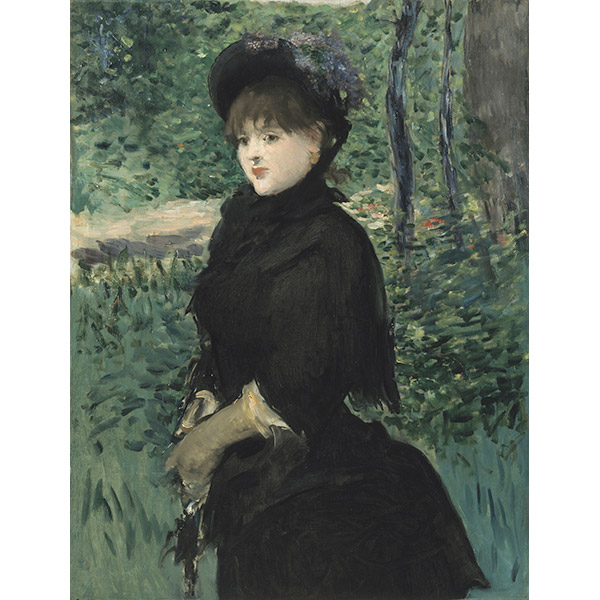
A Stroll
Edouard Manet
ca. 1880. Oil on canvas. 92.3×70.5cm. Tokyo Fuji Art Museum
© Tokyo Fuji Art Museum image archives / DNPartcom
This painting from Manet’s later years depicts a woman strolling through a garden in the outskirts of Paris. Manet’s use of distinctively Impressionistic brushstrokes and his choice of a contemporary subject demonstrate his rebellion against the academism promoted by the Academy. His use of black, a color Impressionists avoided, also hints to his admiration for Spanish paintings.
Part 4:
Drawings
This section features 17 exemplary drawings from the British Museum and the Louvre, 16 of which are on display in Japan for the first time. Artists create drawings not only as preparation or studies for finished works (oil paintings) or as records of their plans and ideas, but also as training to master painting techniques. Although normally rendered in charcoal on paper, many Rococo artists like Watteau created masterful drawings using white, black, and red chalks.
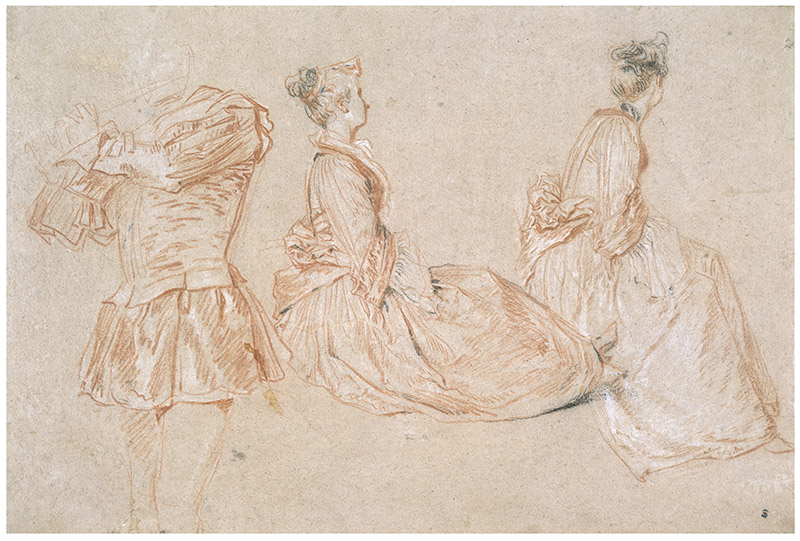
Standing Man Playing a Flute, and Two Seated Women
Jean-Antoine Watteau
ca. 1717. Three color chalks, on brown paper. The British Museum, London
© The Trustees of the British Museum
Watteau, a lover of music and the theater, is said to have used this drawing to plan for his paintings. The lack of a head on the male figure on the left tells us that he was paying more attention to depicting the flautist’s gestures. This figure appears in a few of Watteau’s oil paintings.
Regarding photography in the exhibition hall
Photography is permitted only for the following two works: Venetian Feasts and Gabrielle Yolande Claude Martine de Polastron, Duchess of Polignac. The use of flash and tripods is prohibited.
The Splendor of French Baroque Music
Featuring pieces played on period instruments
This event has been canceled.
In order to prevent further spread of the COVID-19 coronavirus, this event has been canceled. We apologize for the inconvenience, and we seek your understanding and cooperation.
Come on down to Kyushu National Museum for an afternoon of French Baroque music, featuring seventeenth- to eighteenth-century pieces played on the instruments of that era!
Date:
22 February 2020 (Sat)
Time:
15:00 – 15:45 (Session 1)
17:00 – 17:45 (Session 2)
Venue:
Museum Hall, 1st Floor, Kyushu National Museum
Musicians:

Ōta Kōhei,
lute

Ōtsubo Yuka,
baroque recorder

Tanaka Takako,
viola da gamba
Program*:
Couperin, François — Excerpts
from Concerts Royaux No. 3 in A Major
Couperin, François — Le
rossignol en amour
Marais, Marin —
l’Arabesque
Leclair, Jean-Marie — Excerpts
from Trio Sonatas
Visée, Robert de — Excerpts from
Suites
and more
*Concert program is subject to change without prior
notice from the organizers. We seek your understanding and
cooperation.
Admission is free of charge. Registration not required.
